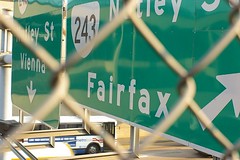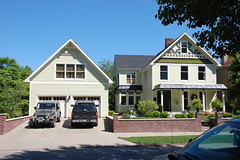
Today was a rarity. I actually got to work faster by bus than I would have by car. I monitored traffic on the web before I left, and I saw the backup from the Orange Line train out of Vienna. I was at work in an hour. The rain and pre-Thanksgiving Beltway bottleneck would have meant at least an hour and a half in a car. Usually public transit just can't compete with the door-to-door service of an automobile; time savings isn't one of the benefits with taking the bus.
So, how did this happen?
One factor was just luck. Buses arrived just in time to make transfers. Usually you have to wait like ten minutes or more for transfers.
Another factor was flexibility. My default way to work involves a bus-to-bus transfer -- the most direct route to the doorstep of my office. Today I took a more circuitous option (bus to Metrorail to another bus) but arrived at my destination faster. Why?
Buses going inbound in the morning (such as my direct option) get caught up in delay just as any vehicle with wheels on the road. Texting NextBus confirmed that bus was indeed very late. So I took Metrorail past the mess and then hopped a bus going outbound (opposite peak traffic).
A third factor was circumstance. Usually buses on Interstate 66 get stuck in traffic just like any vehicle, regardless of occupancy. The high-occupancy vehicle lane on the far left is useless to buses from Centreville after Route 123 because they have to get off on the far right, onto Nutley Street to get to the Metro station. (That express lane is also useless to through traffic after Nutley because the backup getting on the Inner Loop is so bad.)
Today the driver of the bus stayed in the HOV lane till the last minute, cutting across traffic lanes rather late in the game. I'm pretty sure the bus isn't supposed to do that and I'm pretty sure the collective grumpiness of the situation wasn't letting the bus in at its usual merge point. This is actually a dangerous situation, especially in the rain, but the effect was that the bus cut ahead and didn't inch along in traffic as much as it usually does.
A personal factor was willingness to walk. I opted to take the first bus available, which dropped me off three blocks from office instead of the one that drops me off in front. The weather even cooperated with me enough to stop raining when I was on foot. With all the extra time, I dropped by a store to pick up some stuff. I could have sat down for a full breakfast with the morning paper in the pancake house with all that extra time.
So what's that all mean?
Having various ways (and modes) to get to work is a Good Thing. If you aren't ready for the situation, you can't just jump on the best option. In my case, I'm familiar with the traffic patterns and how the highway bottlenecks impact my drive -- I even get updates on my phone. And I know public transit options -- with or without Metrorail, plus their pros and cons. If I hadn't been prepared, I would have been stuck in traffic or waiting over an hour for a bus. I would have been late to work, which isn't a tragedy, but it is annoying and no where as rewarding as time for a sit-down breakfast.
Flexibility is important on a macro scale as well. What if an accident closes down I-66 or the Orange Line or a glitch shuts down traffic lights along Routes 29 or 50?
These kinds of incidents aren't rare lately, and transportation choices help people avoid jams and the region accomodate the occasional mishap.
Today's scenario highlights how the perfect and exceedingly rare alignment of factors puts the bus (plus Metrorail) ahead of a car commute. It doesn't instill confidence in buses, but it shows how buses could be better, how so-called priority buses could benefit all users of I-66, drivers and riders alike.
Most people don't take the bus because it takes too long. In my case, I actually have to transfer to another bus, which is a total deal breaker for most. And buses have to wait in the same traffic as single-occupancy vehicles. But is that fair and what if they didn't?
If an SOV is held up in traffic, one person loses, say, 20 minutes. If a bus is held up, a busload of people lose 20 minutes each -- many hours of lost productivity on a single trip. That's also a busload of discouragement with transit and a busload about to get back in their cars, which makes the I-66 situation worse.
What if the bus didn't wait in traffic like all the SOVs? What if a more exclusive express lane wasn't as clogged as the others? What if the ramps at Vaden Drive, as proposed, let buses bypass the mess at Nutley? What if the Beltway high-occupancy toll lane contruction made the HOV lane usable by express buses clear to downtown? What if today's rarity wasn't so rare?
Suddenly the bus would be winning over more hearts and minds because it wouldn't be running at such a time deficit. It would be more marketable to more people and more competitive against the highway. And the real win-win is that the more people taking transit (because it benefits them!) makes the road more pleasant for those who can't take transit.









 The first package describes a network of priority bus corridors, the centerpiece of which is the K Street Transitway subpackage focused on improving accessibility and mobility in the city core, the final destination for many surburban commuters. The only component actually on I-66 is a ramp in the median of I-66 providing direct access to and from the left express (HOV) lanes to the Vienna Metrorail station. That could mean big time savings for commuter buses that get caught in the rush-hour backup around the Nutley Street exit. It can also mean less disruption to traffic and a safer situation for buses trying to weave from leftmost HOV lane to the rightmost turn lane.
The first package describes a network of priority bus corridors, the centerpiece of which is the K Street Transitway subpackage focused on improving accessibility and mobility in the city core, the final destination for many surburban commuters. The only component actually on I-66 is a ramp in the median of I-66 providing direct access to and from the left express (HOV) lanes to the Vienna Metrorail station. That could mean big time savings for commuter buses that get caught in the rush-hour backup around the Nutley Street exit. It can also mean less disruption to traffic and a safer situation for buses trying to weave from leftmost HOV lane to the rightmost turn lane. The second package is a regional bicycle-sharing program that would put bike-share stations across the region, including Arlington County and the City of Fairfax. The region-wide program also includes so-called high-tech intermodal smart hubs that provide transit information and facilitate transfer from different modes (such a bicycle to Metrorail or Zipcar).
The second package is a regional bicycle-sharing program that would put bike-share stations across the region, including Arlington County and the City of Fairfax. The region-wide program also includes so-called high-tech intermodal smart hubs that provide transit information and facilitate transfer from different modes (such a bicycle to Metrorail or Zipcar).



